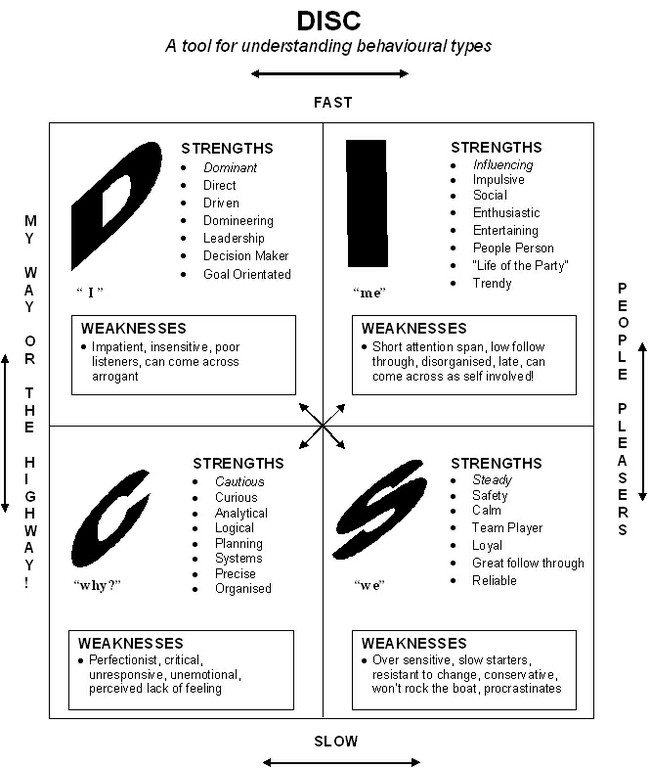OK now I know their DISC - What do I do? [article] 6
After reading the previous articles you should have a pretty good understanding of the different DISC behavioural styles, their common traits and how each DISC style needs to be approached and interacted with. But how do you change your own ingrained behaviour to meet that particular clients needs? And should you?
The simple answer is yes – you are the professional and they are paying you for the best service you can provide. Surely the best service includes providing it in a way that means the most to your customers?
Take a look at the chart below:

Everyone tends to have a strongest DISC style, and quite often a secondary one. These tend to go around the square. For example you might have someone who is an I-D. This I-D person is likely to be social, chatty and loud, and also like to have control and get things done quickly and efficiently. As behaviour is fluid – and changes in different situations, they may be more ‘I’ in their social setting, and flip more into ‘D’ mode at work.
Similarly, you might have someone who is S-C. They are caring, quiet and considerate – especially around their family and friends, and then at work go more into ‘C’ mode, analysing data, asking questions and focusing more on the task. How your DISC is made up is represented by the scores you got in the scorecard you completed in article one ‘How to win clients and influence people’.
You don’t often get a dominant and secondary DISC that runs diagonally across the square (see arrows above). These styles seem to clash rather than compliment each other. For example, a high D is going to appear very dominant and aggressive to a timid S style. Similarly, the I and the C often clash, as the I wants to get on with things quickly, gossip and generally have a good time, while the C wants to find out all the details of the task at hand and work through it slowly and methodically.
Self awareness is the key to using DISC effectively. You must be aware of the strengths, weaknesses and behaviours associated with your dominant style, and the effect that these traits can have on other DISC styles.
Let’s look at an example of meeting a new client in the gym.
Meeting a new client for the first time:
If your new client is a D you need to:
- Keep things fast, efficient and focused on the task
- Use confident body language and communication
- Give them a certain amount of power, but be direct when required
- Stroke their ego and acknowledge their achievements where appropriate
- S’s – speak with authority, speed up and don’t take things personally!
If your new client is an I you need to:
- Keep thing fast, snappy and entertaining
- Ask lots of questions about them and let them do the talking
- Compliment them where appropriate
- Rein them in tactfully if they get too off track
- C’s – avoid focusing on the task and the details, don’t be ‘boring’!
If your new client is an S you need to:
- Slow down, take them somewhere quiet and be discreet
- Speak softly and really take care of them
- Tell them exactly what to expect from the session, the gym, and you as their PT
- Check that they are comfortable with any recommendations that you make
- D’s – be soft, slow down, focus on them as a person and how they feel
If your new client is a C you need to:
- Find out exactly what they want and why they are here
- Explain everything slowly, in detail and be task focused
- Give them time to digest information and ask questions
- Use facts and figures when possible and give all options
- I’s – SLOW down, focus on the details of getting them started - remember it’s not all about you this time, it’s about the task at hand!
In summary:
DISC is a set of general guidelines rather than a rule. Remember that people are unique and will always surprise you. However understanding yourself and your clients better increases your chance of nailing that first impression with a potential client. It also provides a tool for improve existing relationships with your current clients, increasing your success in the competitive world that is Personal Training.
Food for thought:
What DISC types would you most like to work with?
Who would you struggle with and how can you improve this?
For further reading on DISC check out ‘The 4-Dimensional Manager’ by Julie Straw, available at www.amazon.com
